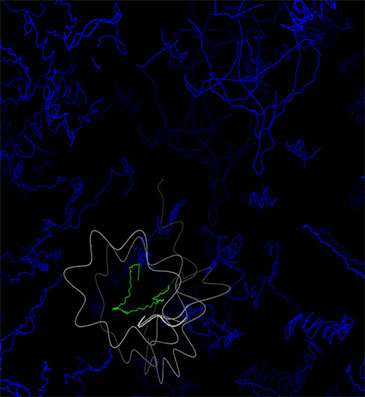Chemistry in a trillionth of a second

Chemists at the University of Bristol, in collaboration with colleagues at the Central Laser Facility at the Rutherford Appleton Laboratory (RAL) and Heriot-Watt University (HWU), can now follow chemical reactions in liquids with unprecedented, atomically resolved detail on sub-picosecond timescales (1 picosecond = 10-12s) – matching the time intervals between molecular collisions.
Many important chemical processes occur in liquids, including the biochemistry of living organisms, the environmental chemistry in rivers, lakes and oceans, and the synthesis of drug molecules by the pharmaceutical industry. But, what really happens during these chemical transformations?
Atoms and molecules are far too small to see, even using the world's best microscope. Moreover, in the close quarters of a liquid, each molecule experiences about ten trillion collisions every second.
In work published today in Science, the researchers combine ultrafast laser spectroscopy in the infra-red spectral region and cutting-edge computer simulations to study the reaction of a fluorine (F) atom removing a deuterium (D) atom from an organic solvent molecule to make deuterium fluoride (DF).
This type of reaction has been previously studied in detail in the gas phase, without the attendant complications of the surrounding solvent molecules. Differences in the outcome of the chemical reaction in a liquid therefore reflect the influence of the solvent on the reacting atoms and molecules.
The researchers identified a series of important fundamental steps of the chemical reaction, including the flow of the energy released by the reaction into stretching of the DF bond; the formation of hydrogen bonds between the DF product and the solvent within 1 picosecond of reaction; the subsequent dissipation of energy into the surrounding solvent as heat; and reorientation of the solvent molecules around the DF to accommodate this polar reaction product. This whole series of chemical steps is over in about 50 picoseconds.
Lead authors Dr David Glowacki and Professor Andrew Orr-Ewing of the University of Bristol said: "Because chemical reactions occur on extremely fast timescales, it's a real challenge to develop intuitive pictures of how they happen. This study demonstrates the power of combining computer simulations and ultrafast laser spectroscopy to understand and visualize fundamental chemical processes.
"We are only now beginning to unravel precisely how solvents influence chemical reactions at a molecular level. The computational and experimental methods we use have many applications for advancing our understanding of the fascinatingly complex fields of organic and biological chemistry."
More information: "Vibrational relaxation and microsolvation of DF after F-atom reactions in polar solvents." Science 30 January 2015: Vol. 347 no. 6221 pp. 530-533 DOI: 10.1126/science.aaa0103
Journal information: Science
Provided by University of Bristol














.jpg)




